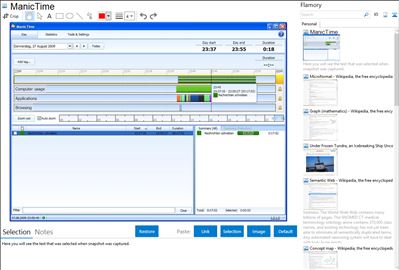

Otherwise, use AOM codecs, known for poor multithreading, to encode at full speed without hogging CPU. Best to already have a home server (any spare desktop). This technique isn't as effective for this use case of recording several hours daily, since reencoding must be fast enough on average to keep up.
Delete history manictime Pc#
For onscreen content, I prefer the bitrate tradeoff of keeping PC color range and not chroma subsampling. Fullscreen video does not, instead gradually filling the write cache until either OOM or thrashing. Typical screen content compresses well below the ~100 MB/s write speed of an HDD.

An SSD can handle even uncompressed 24bpp 1080p60, which is 375 MB/s. Of the lossless encoders in OBS/libav, utvideo was the best in both CPU usage and efficiency, followed by lossless ultrafast x264. I didn't write any numbers down, but the difference in efficiency was significant.

You can of course do this with git, but if you're working on something visual it can be nice to see it in motion rather than a textual diff.Ī while ago I tried to see what compression I could get out of screen recording losslessly to a scratch disk and encoding afterwards as slowly as I could wait. I can know what I was working on a given day, see how far I've progressed, it's just generally a good motivator. * It allows me to go back and see my progress. I've stepped through videos frame by frame in the past to debug, it's been surprisingly helpful. If something visually interesting happens, or if there's graphical bug of some kind, I can go back and breakdown exactly what happened. * I'm working on video games which is what makes this very useful for me. I'm not using the same tools or even on the same operating system. I have a few videos of myself working from 2015 which I think is pretty neat just because of how different my workflow was back then compared to now. * It allows me to go back and see how I worked in the past. It started as an attempt to mimic this feeling at home, even though I'll be the only one to ever see the recordings. If I'm in an office anyone can look over and see whether or not I'm working. * It's a mental hack to keep me accountable, especially now working from home. I've gotten mixed reactions whenever I share this, but when I program I like to record my screen with OBS. When you look at it like that, those of us who grew up in that environment would look at a screenshot from that era the same way others might look at random photos from high school. It felt like we all grew up together because, kinda, we did. Many were at my wedding even, and in one case that was the first time I had ever met them IRL. Even all these years later, the people I met virtually during that time are still some of my best and closest friends, and it's a real treat when my travels take me close enough that we can meet for coffee or lunch. Without them, there's a very real chance I might not be here today.

Many days in the 90s it felt like going to school was the thing I had to put up with, and logging in and seeing my friends when I got home was my real life. It didn't matter where we were, what we looked like, or how we did or didn't fit in. Many of the people I played and chatted with were fellow social outcasts, and we created our own parallel virtual communities to support and lift each other up. I had a few IRL friends, but the very vast majority of my social interaction during that time came via MUDs and chatting. I struggled a lot as a teen with anxiety, depression and bullying. I never really thought about it from this angle, but there is a lot of truth to this. You know, this is a very enlightening point. But then if you were spending 90% of your time online as a teen/early 20s it's not that surprising on a second thought.


 0 kommentar(er)
0 kommentar(er)
